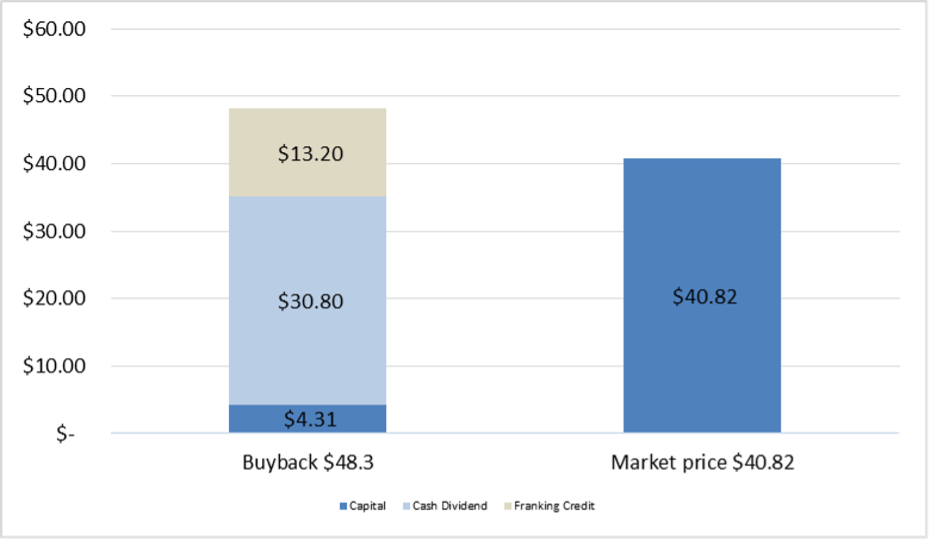A triple treat in one of the biggest reporting seasons for income
It was expected to be a sound reporting season for dividend investors, but so far it’s one that has exceeded the expectations of many.
For those invested in Australian equities for income, August has delivered a triple treat – strong dividends, special dividends and buybacks.
From a cash perspective the total amount to be paid to shareholders could well make it the biggest reporting season (in cash terms) on record.
Over $38 billion in dividends have been declared so far - $17 billion more than this time last year.
The strong dividends
While many of the traditional income stocks have been underperformers in recent years, this year they’re on the comeback trail.
We think it’s safe to say income investors can once again bank on the big 4 banks.
As APRA restrictions have been lifted and it’s become apparent that many of the expected dire outcomes of COVID-19 have not eventuated, shareholder income is being boosted.
Australia’s biggest bank, the Commonwealth Bank (ASX: CBA), is arguably the standout performer based on its annual results, released August 11.
CBA reported a net profit after tax of $8.65 billion, which was up 20% compared to the previous year and it announced a final dividend of $2, taking the total for the year to $3.50 a share, fully franked. That final dividend is a significant 104% increase on the final dividend in 2020.
We think dividends from CBA and other big banks can grow further over the coming 12 months, supported by healthy Tier 1 capital ratios and stronger revenues.
The other traditional income name to report encouraging results is Telstra (ASX: TLS). While historically a so-called dividend darling, it has been an underperformer in recent years.
However, Telstra’s full year results indicate the business has reached a turning point.
With net profit after tax of 1.9 billion, up 3.4% from last year, it flagged mid to high single digit profit growth in 2022, based on stronger earnings in the mobile market and costs associated with the NBN tapering off.
What’s most significant about the re-emergence of the traditional income players, is the fact the strong dividends from non-traditional sectors (that have been filling the void in recent years) haven’t abated – dividends are strong all round.
Iron Ore miners have become the new dividend darlings and whilst iron ore prices have pulled back from recent highs, iron ore miners are still very profitable at current price levels.
Investors have been handsomely rewarded over the past month.
Fortescue Metals (ASX:FMG) declared a record final dividend of $2.11, more than double its final dividend in 2020. This equated to a gross yield (incl. franking credits) of 15.1% just for this dividend.
BHP (ASX:BHP) declared a record final dividend of US$2.00 (gross yield of 7.6% for this dividend), up 264% on 2020.
And in late July, Rio Tinto (ASX:RIO) (which announced half-year results) lifted its interim dividend 135% to $5.09 (gross yield of 5.5% for this dividend).
The strength of the retailers has also continued.
Woolworths (ASX: WOW), Metcash (ASX:MTS) and Super Retail Group (ASX: SUL) have all declared big dividend increases and posted robust results.
The special dividends
On top of strong dividends, more than a billion dollars in special dividends has also been announced.
Rio Tinto is the standout in the special dividends category. On top of its $5.09 interim dividend, investors will receive a special dividend of $2.51, bringing the total payout to $7.60 per share (a gross yield of 8.2%).
Other special dividend payers include Bluescope Steel (ASX: BSL) (19c on top of 25c normal dividend), Oz Minerals (ASX: OZL) (8c on top of 8c normal dividend), South32 (ASX: S32) (2.76c on top of 4.82c normal dividend) and Suncorp (ASX: SUN) (8c on top of 40c normal dividend)
The $8 billion buyback bonanza
The icing on the cake for income investors this reporting season has been two major off-market buybacks.
Retirees and other low-tax investors will be the biggest beneficiaries as franking credits are the most tax-effective form of income for pension phase and tax-exempt investors.
Last week, as Plato predicted, Woolworths announced a $2B off-market buyback.
We have analysed the value of the buyback for tax-exempt investors using the market price of Woolworths on August 25 of $40.82 (see Chart below).
Using $40.82 as a guide (the actual price used for the buyback will be the volume weighted average price of Woolworths shares in the five trading days up to and including October 15, 2021) the maximum 14% discount would equate to a $35.11 buyback price. With the capital component being $4.31, the other $30.80 would represent a fully franked dividend, which would have a $13.20 franking credit attached. For a tax-exempt Australian investor, we estimate the buyback at a 14% discount would be worth approximately $48.30 (disregarding the time value of money), representing an after-tax profit of $7.48 or 18% compared to the market price of Woolworths today.
Estimated value of the Woolworths buy- back for tax exempt investors.

Source: Plato, Woolworths buy-back announcement 26 August 2021.
The Woolworths buyback followed the announcement of a major $6 billion off-market buyback by Commonwealth Bank, which we estimate would deliver a 14% market price premium for retirees who tender shares.
If you’re a retiree, tendering shares into buybacks can help deliver significant additional after-tax alpha. Similarly, if you’re invested in a managed product, you should ask your portfolio managers if they tender to off-market buybacks. If not, it’s likely your investment is not being managed to optimise income specifical for retirees.
Other shareholders who don’t participate in these buybacks still benefit to the extent that shares are effectively bought back at a cash discount to market price. This compares with on-market buybacks, where companies buy back stock at market price.
It's a great time for equity income
The ‘triple treat’ will provide a much-needed income boost at a time when cash rates make in nearly impossible to achieve meaningful income from so-called safe cash investments, such as term deposits and fixed interest.
While this reporting season may return the most cash to investors ever, in yield terms it’s unlikely to surpass previous records. We think that’s not far away though – the results of the past month indicate many dividend paying companies are likely to further increase their yields in the foreseeable future.
And with so many strong dividend payers across various sectors, portfolio diversification – the only free lunch – is very achievable.
Get more income from your retirement capital
Plato Investment Management specialises in maximising equity income for retirees and other low-tax investors. Visit the Plato website for more information.

3 topics
12 stocks mentioned
1 fund mentioned

